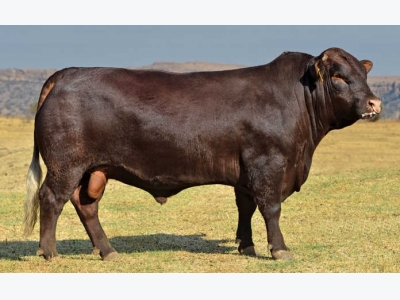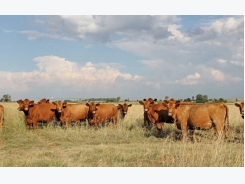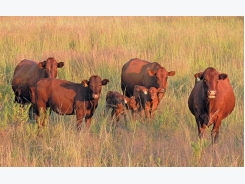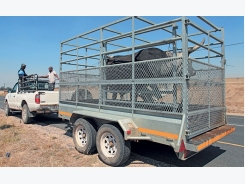Beef cattle conformation basics

When performing a visual evaluation of the animal, note the following features in particular: frame size, muscle and body structure, and breed character.
The quality of its individual features – head, neck, chest, topline, rump, legs and scrotum – and the well-balanced overall appearance of this Sussex bull make this a fine specimen of the breed.Photo: FW Archive
In a breeding herd, you need to select animals that possess traits for a long life, reproductive efficiency, efficient feed to meat conversion, and a type that will produce desirable carcass composition and performance.
The ability of the individual animal to meet these requirements is shaped by heredity and the environment.
Today, production records are used to determine an animal’s genetic potential and its response to the environment. But these records do not tell the whole story. Physical characteristics remain important, and visual evaluation is still a key part of the selection process.
It takes training and experience to accurately evaluate features. The following is merely a broad guideline of what to look for:
Body structure
The neck should be moderately long (an indicator of growth). The loin and rump should be long, wide and level, so that the top of the animal is long and strong.
Extremely short-bodied and short-legged cattle are associated with excessive fat and inefficient growth. Excessively long legs and long bodies are associated with late maturity and low-quality grades.
The rump of a beef animal should be deep and wide when viewed from the rear, with the widest portion about midway between the tail-head and hock. The shoulders should be well muscled. Extremely heavy, open shoulders can lead to calving difficulties.
A beef animal should be moderately trim in the rear flank, underline and brisket to prevent excessive waste. The chest floor and spring of ribs should be wide, indicating body capacity and overall productiveness.
Muscle structure
Bulls: Thick, heavy and long muscling is desirable. This is indicated by length and size of muscling in the forearm and gaskin areas, and width and bulge of muscling in the stifle area when viewed from the rear and side. Thickness, length and bulge of muscling in the back, loin and round indicate muscling in the areas of the carcass with the highest-priced wholesale cuts. Avoid selecting an animal with extreme muscling, so that its movement is impaired or it appears double-muscled.
Females: Muscling should be long, smooth and moderately thick. Short, coarse and bulky muscling is usually a sign of poor reproductive efficiency and milk production.
Feet and legs
In a beef animal, the legs should be squarely set under the four corners of its body. The shoulders should not be too straight; this is an indicator of leg problems.
Do not select an animal with signs of being post-legged, knock-kneed, splay-footed, sickle-hocked or buck-kneed or one with short, straight pasterns. The animal should move freely and easily.
Frame/skeletal size
Frame size indicates growth and, indirectly, the composition (fat-to-lean ratio) of a beef animal. A large-framed animal is leaner at a given weight than a small-framed one. Frame size is related to the slaughter weight at which an animal should attain a given amount of fat thickness.
Reproductive soundness
Bulls: A mature bull should show a burly, masculine head with coarse hair, a heavy jaw, and heavy muscling in the neck and shoulders.
The testicles should be well-developed and properly balanced in relation to the animal’s age and size. The scrotum and testicles should be at least 30cm in circumference on a 12-month-old bull to indicate adequate reproductive ability.
Cows and heifers: A female should show femininity, with a lean, refined head and long, narrow and clean neck. Its overall body shape should be slightly angular, with a small dewlap down the throat and in the brisket area. The shoulder blades should extend to the top of the vertebrae, giving a lean appearance to the top of the shoulders, which should be moderately muscled and clean.
A productive cow will have a broad chest and large spring of ribs, indicating adequate body capacity. Females should be wide and long from hips to pins, and deep from the pins to the stifle joint, indicating calving ease.
The widest portion of the fertile cow should be in the midrib. A fertile female will have a level top line as opposed to a high tail-head.
The udder should be strongly attached with a level floor, and teats should be proportional to body size.
Source: ‘An analysis of beef cattle conformation’, by Dr Brett Barham et al (University of Arkansas, Division of Agriculture)
Related news
Tools

Phối trộn thức ăn chăn nuôi

Pha dung dịch thủy canh

Định mức cho tôm ăn

Phối trộn phân bón NPK

Xác định tỷ lệ tôm sống

Chuyển đổi đơn vị phân bón

Xác định công suất sục khí

Chuyển đổi đơn vị tôm

Tính diện tích nhà kính

Tính thể tích ao




 5 Cattle diseases that can kill your business
5 Cattle diseases that can kill your business  Tips for stress-free livestock transporting
Tips for stress-free livestock transporting